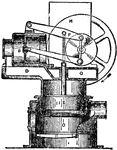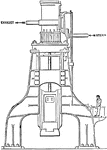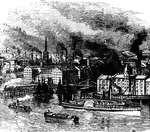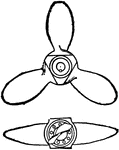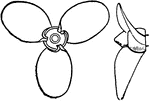Pitman
A rod which connects a rotary with a reciprocating part, either for imparting motion to the latter or…
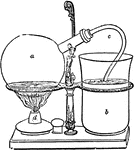
Napier's Coffee Apparatus
"This coffee apparatus consists of a glass globe a, an infusing jar b, of glass or porcelain and a bent…
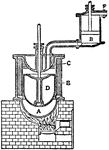
Stirling's Air Engine
"A form of air-engine which was invented in 1816 by the Rev. R. Stirling is of special interest as embodying…
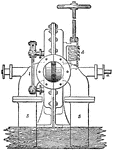
Reaction Turbine
"Professor James Thomson's inward flow or vortex turbine has been selected as the type of reaction turbines.…
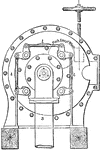
Reaction Turbine
"Professor James Thomson's inward flow or vortex turbine has been selected as the type of reaction turbines.…
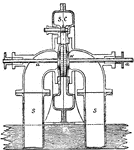
Reaction Turbine
"Professor James Thomson's inward flow or vortex turbine has been selected as the type of reaction turbines.…
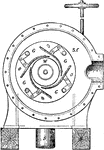
Reaction Turbine
"Professor James Thomson's inward flow or vortex turbine has been selected as the type of reaction turbines.…
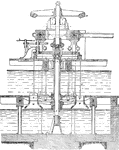
Girard Turbine
"The general sectionl elevation of a Girard turbine, in which the flow is axial. The water, admitted…
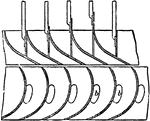
Guideblade Chamber
"The sectional form of the guideblade chamber and the wheel and the curves of the wheel vanes and guideblades,…

Guideblade Chamber
"The sectional form of the guideblade chamber and the wheel and the curves of the wheel vanes and guideblades,…

Centrifugal Pump
"A centrifugal pump differing from an ordinary centrifugal pumps in one feature only. The water rises…

Retort
"A peculiar-shaped vessel called a retort is half filled with a volatile liquid and heated; the steam,…
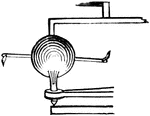
Hero's Machine
"Hero's Machine. The generation of steam from water by the application of heat, and the mechanical force…
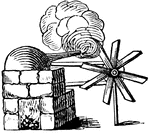
Brancas Engine
"In 1629 Giovanni Branca, an Italian, contrived a machine which was employed for the various purposes…
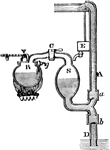
Savery Engine
"Savery's Steam Engine. The adjoining figure illustrates the apparatus employed by Savory. It consists…
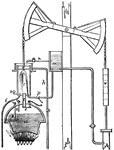
Newcomens Engine
"The simple outline of the atmospheric engine. Its mode of operation is as follows. Steam is admitted…

Double-acting Cylinder
"The first alteration to be noticed in the double-acting engine is that of the cylinder. To insure its…

Double-acting Cylinder
"The first alteration to be noticed in the double-acting engine is that of the cylinder. To insure its…

Crank
"The simplest idea of a crank is that of a handle to a wheel; its action is familiarly illustrated in…
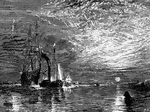
Fighting Temeraire
This painting by J. William Turner is a prime example of the style and technique that he often used.…

Steamboat
A steamboat constructed by Robert Fulton, which made the passage from New York to Albany in thirty six…

Connecting Rod of a Steam Engine
This illustrates how to determine the force required to turn a connecting rod of a steam engine.
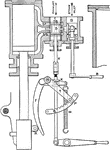
Valve gear of a steam hammer
"The valve gear for operating the steam hammer is shown separately, the cylinder and valve chest being…
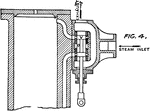
Vertical Section of a Double-Hammer Column
"A vertical section through the valve casing of a double-column hammer, used for heavy forge work."—Finley,…

Transverse Section of a Double-Column Hammer
"A transverse section through the valve casing of a double-column hammer, used for heavy forge work."—Finley,…
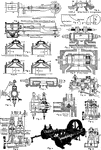
Steam engines
"The steam engine, in its many forms, is the agent by means of which part of th eenrgy stored up in…
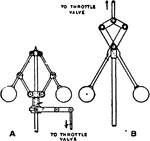
Watt's governor
"Watt's method of regulation, which consists in varying the pressure of the steam supplied to the engine…

Reduction of Copper Oxide
"When heated, hydrogen will combine with the oxygen of many oxides, forming water (steam) and the metal,…

Composition of Water
"If dry hydrogen is passed over a weighed quantity of copper oxide which is heated, steam and copper…
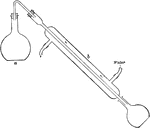
Distilling Apparatus
In order to rid water of impurities, it is required to boil water, then condense the steam to make it…
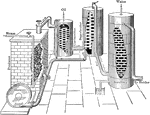
Water Gas Production
"The chief use of carbon monoxide is in water gas. This is produced by the reduction of steam by heated…
!["Tyndall's experiment illustrating the production of heat by friction. The wheel is rotated and heat is produced [by friction] that heats the water in the end of the brass tube, which causes the water to boil, producing steam which pops off the cork." -Hawkins, 1917](https://etc.usf.edu/clipart/35600/35656/tyndall_35656_mth.gif)
Tyndall's Experiment
"Tyndall's experiment illustrating the production of heat by friction. The wheel is rotated and heat…
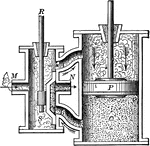
Steam Engine
"The steam engine is a powerful device for utilizing the energy involved in the elasticity and expansive…
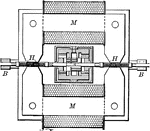
Tesla's Oscillator
"Tesla's oscillator is a combined prime motor and electric generator, and produces alternating currents…
!["Steam pumps are force pumps operated by steam acting on the piston of a steam engine directly connected to the pump, and in many cases cast with the pump. A section of a double-acting steam pump, showing the steam and water cylinders, with other details, is illustrated [here]." —Hallock 1905](https://etc.usf.edu/clipart/36100/36172/steam_pump_36172_mth.gif)
Steam Pump
"Steam pumps are force pumps operated by steam acting on the piston of a steam engine directly connected…
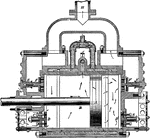
Air Compressor
"For many purposes compressed air is preferable to steam or other gas for use as a motive power. In…
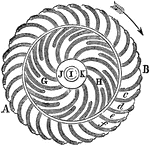
Water Turbine
"Water enters through J and K following into G and H compartments. Afterwards the water is forced into…
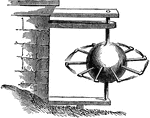
Hero's Steam Engine
"High volumes of steam were pumped into the hollow sphere. The steam would then escape through the many…

Savery's Engine
"Handle A opens and closes valves B and G. Steam is injected through pipe S which flushes any air/water…
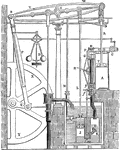
Watt's Double-Acting Condensing Steam-Engine
"Used a boiler to produce steam, chambers to condense it, and drive the pistons of the engine." —Quackenbos…

Blast Furnace
A machine that blasts hot air to produce temperatures from 600 to 900 degrees Fahrenheit.
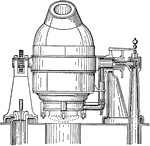
Bessemer Converter
Sir Henry Bessemer invented this furnace that creates "Bessemer steel" by burning carbon out of cast…
